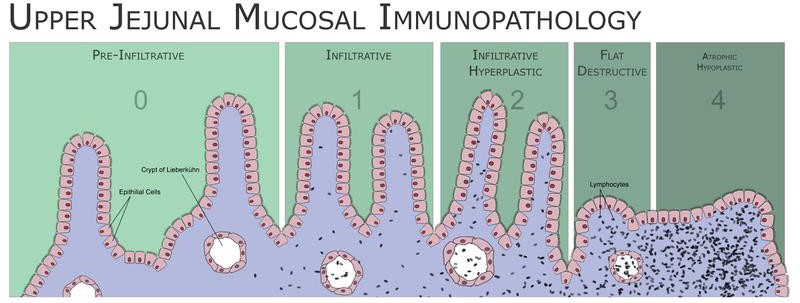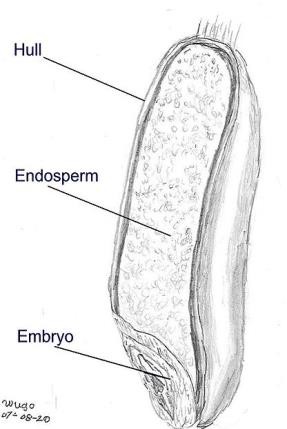Chapter 4: Common Digestive Problems
4.6 Celiac Disease & Gluten
1 out of every 133 people in the United States has celiac disease.[1] People with celiac disease cannot consume the protein gluten because it causes their body to generate an autoimmune response (immune cells attack the body’s own cells) that causes damage to the villi in the intestine, as shown in Figure 4.61.

This damage to the villi impairs the absorption of macronutrients and micronutrients from food.
There are a variety of symptoms for celiac disease that vary depending on age and from person to person. Digestive symptoms are more common in children and may include diarrhea or constipation, gas, nausea/vomiting. Adults are less likely to experience digestive symptoms. Symptoms in adults can include anemia, bone or joint pain, headaches, infertility, and seizures.[2] The web link below describes the difficulty in diagnosing this disease, which is reinforced by the video link.
Web Link: Celiac Disease, a Common, but Elusive, Diagnosis
Video Link: Celiac’s Disease (2:00)
The symptoms can appear in infancy or much later in life, even by age seventy. Celiac disease is not always diagnosed because the symptoms may be mild. A large number of people have what is referred to as “silent” or “latent” celiac disease.
Villi destruction is what causes many of the symptoms of celiac disease. The destruction of the absorptive surface of the small intestine also results in the malabsorption of nutrients, so that while people with this disease may eat enough, nutrients do not make it to the bloodstream because absorption is reduced. The effects of nutrient malabsorption are most apparent in children and the elderly as they are especially susceptible to nutrient deficiencies. Over time, these nutrient deficiencies can cause health problems. Poor absorption of iron and folic acid can cause anemia, which is a decrease in red blood cells. Anemia impairs oxygen transport to all cells in the body. Calcium and vitamin D deficiencies can lead to osteoporosis, a disease in which bones become brittle.
What is gluten?
Gluten is a protein that is bound to starch in the endosperm of grains such as:
- Wheat
- Barley
- Rye
- Triticale

Gluten-free diets have been increasing in popularity even for people who don’t have celiac disease. The thinking among those consuming these diets is that they might be gluten-sensitive, meaning that they experience adverse effects from consuming it. However, as the following videos describes, there is not much evidence to support people being gluten-sensitive.
Video Link: Is Gluten-Sensitivity Real? (3:11)
Celiac disease is most common in people of European descent and is rare in people of African American, Japanese, and Chinese descent. It is much more prevalent in women and in people with Type 1 diabetes, autoimmune thyroid disease, and Down and Turner syndromes.
Symptoms can range from mild to severe and can include pale, fatty, loose stools, gastrointestinal upset, abdominal pain, weight loss and, in children, a failure to grow and thrive.
Villi (singular: villus) are finger-shaped projections from the inner wall of the small intestine.
Nutrients that are needed in large amounts and can be processed by the body into cellular energy - protein, fats and carbohydrates.
Micronutrients are nutrients required by the body in lesser amounts, but are still essential for carrying out bodily functions. Minerals and vitamins are micronutrients.
Anemia is when a person's ability to carry oxygen throughout the body is lowered, due to a lack of red blood cells and/or hemoglobin.
Infancy is the earliest part of childhood. It is the period from birth through age one.
Osteoporosis is a condition where the bones become fragile due to loss of bone density.

